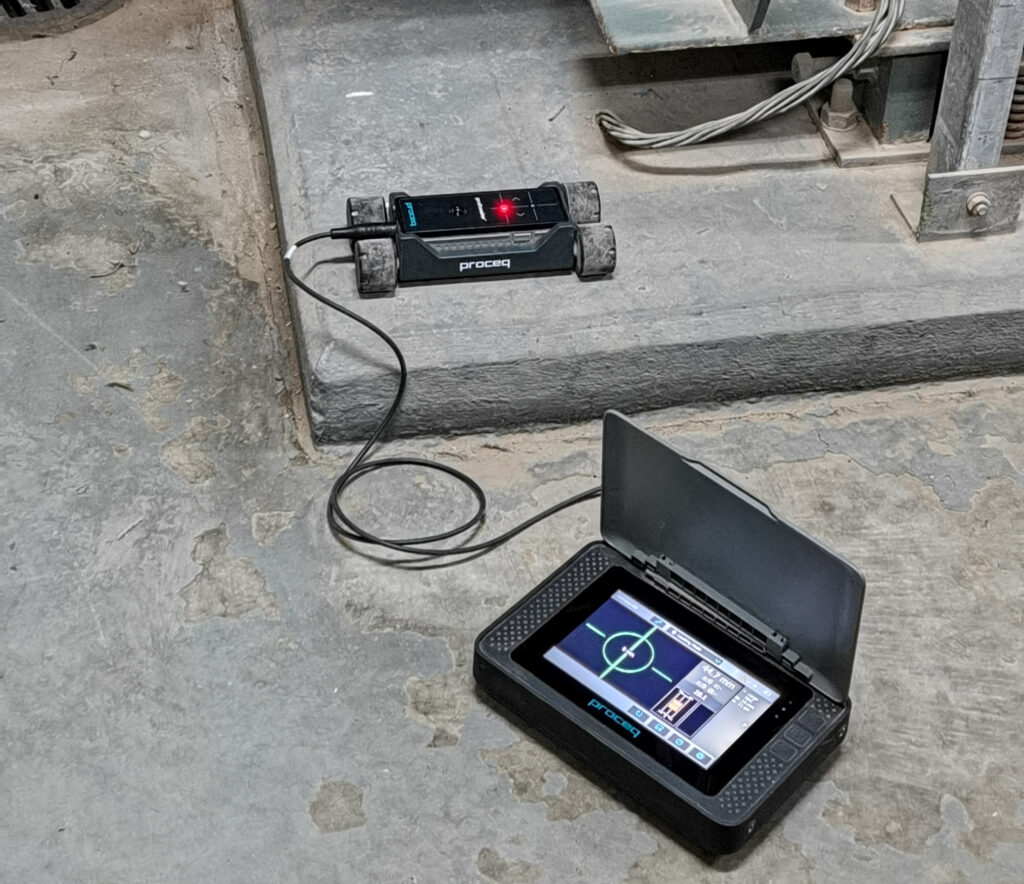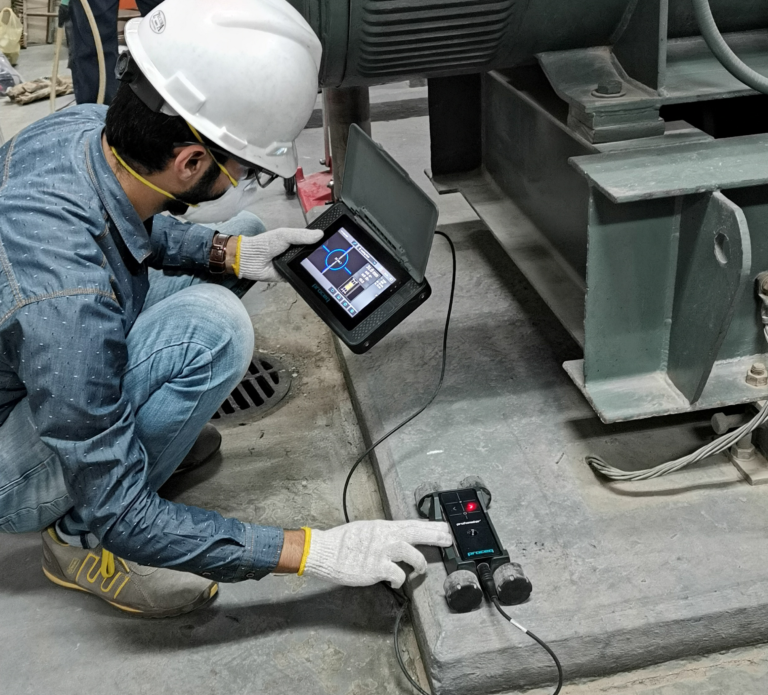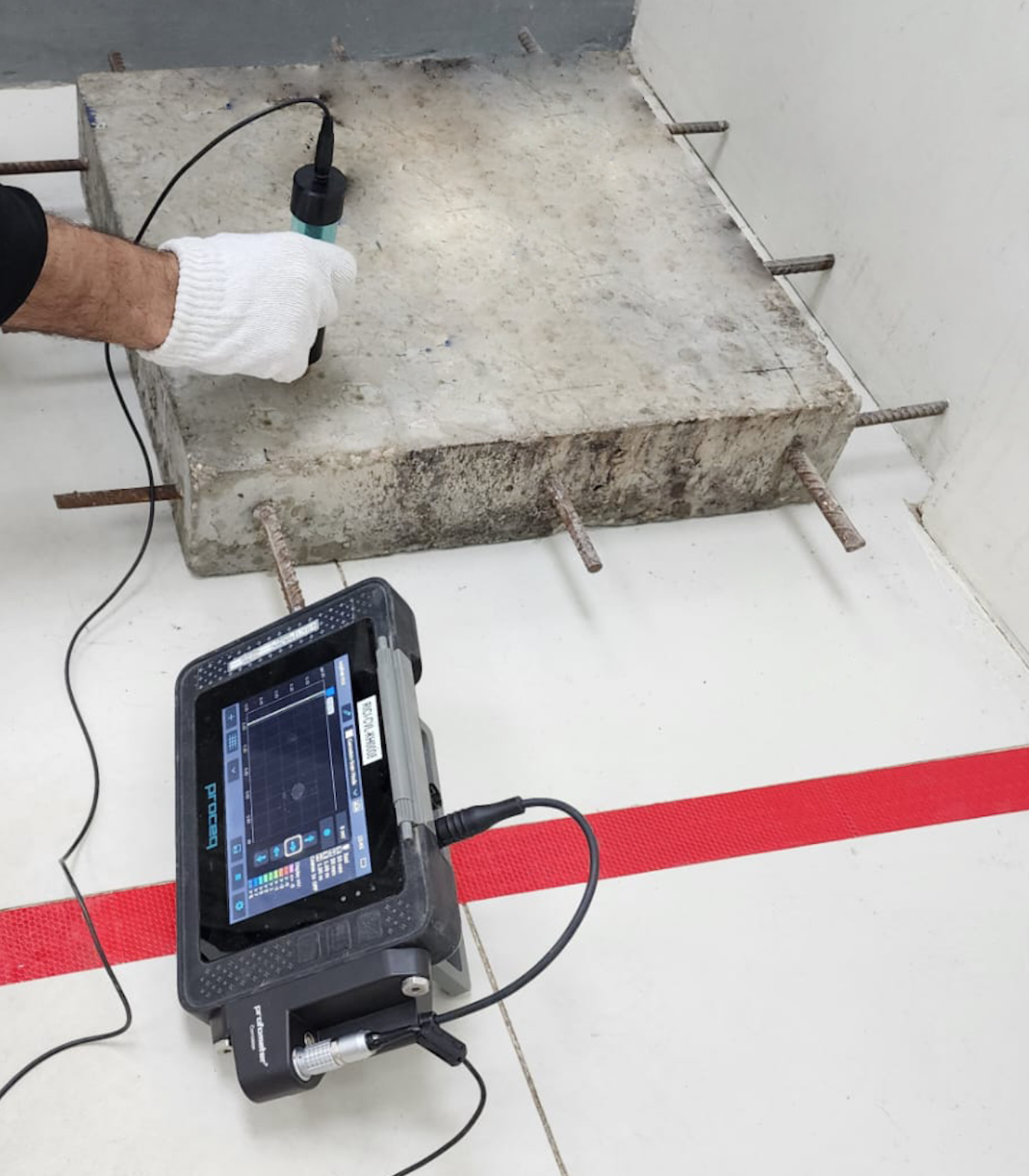TPTL, Civil Technician, Civil Material Testing, Field Density Test, Nuclear Density Gauge, Hardened Concrete, Asphalt Concrete, Marshall Stability, Modified proctor, Bearing capacity Test, Ultrasonic pulse velocity,
NON-DESTRUCTIVE TESTING
The strength and integrity of concrete structures have become a major concern to many countries in the world. To ensure the accuracy of concrete prior to its use in designated structures, numerous techniques have been developed which can be performed without damaging the concrete. Such techniques include Non-Destructive testing which has become a breakthrough for concrete and steel structures.
Both existing and new structures can be inspected using NDT methods. However, the fundamental aims of applying NDT methods to new structures are probably quality control or clearing up any uncertainty of the materials or constructions.

NDT Benefits
Concrete condition assessment has been carried out for many years mostly by visual inspection, surface sounding, and coring to analyze internal concrete conditions; mostly the destructive methods whose biggest drawback is that they will destroy at least a part of the item under examination. On the other hand, Non-destructive testing techniques are the appropriate methods for the condition assessment without damaging the test specimen.
Assessment through NDT can provide the details related to structural effectiveness of concrete such as determination of crack depth; voids and honeycomb presence; delamination and debonding; member dimensions; steel reinforcements size and location; extent of damage from freezing, fire or chemical exposure; and corrosion conditions of the reinforcements.
Non-Destructive testing techniques have many advantages, some of them are listed below:
- Improving the confidence level in fewer destructive tests
- Evaluation of the construction quality such as in situ structures and precast yards.
- Results/ conclusions can be drawn on an immediate basis after performing the tests
- Determining the location, density, or corrosion condition of reinforcements in the structure.
- Determining the position of cracks, honeycombs, voids and related defects within the concrete structure.
- Repetition of testing on the same sample, i.e., NDT can be performed multiple times on the same sample.
- Providing information for any envisioned change in a structure’s usage for insurance or a change in ownership.
- Identifying the uniformity of the concrete, possibly prior to core cutting, load testing, or other conventional tests.
- Eliminating doubts about the acceptability of the delivered material due to apparent non-compliance with specification.
- Confirmation or negation of any skepticism about the craftsmanship implicated in the batching, mixing, pouring, compacting, or curing of concrete.
- Verification or identification of concrete deterioration caused by overstressed conditions, fatigue, chemical attack or change, fire, explosion, or environmental influences.
Non-destructive techniques can also be performed on soil to study and investigate different parameters. Commonly bearing capacity of soil can be analyzed by using an NDT method known as plate bearing reaction test. Furthermore, other NDT techniques are also utilized in soil analysis which can give knowledge about soil’s properties without having any damage on the soil such as Bender Element is test used in soil examination to estimate the soil’s small-strain shear modulus (Gmax).
Why RICI ?
We are a leading 3rd party service provider with more than 30 years of experience, we assist companies in all quality related requirements such as Civil Material Testing, Calibration, Inspection, Certification, Training and much more with operational presence in most of KSA construction trending hubs.
Methodologies
Non-destructive testing on concrete is used to determine its compressive strength and other qualities for both existing structures and newly prepared concrete. The concrete structure’s actual strength and qualities are revealed along with immediate results. In the case of soil testing, NDT techniques are employed to examine the bearing capacity of soil and small-strain shear modulus (Gmax) which helps to understand the elastic behavior of soil, etc. The normal used non-destructive techniques for concrete and soil examination are grouped into the following.

Ultrasonic Pulse Velocity Testing
(UPV) (ASTM C597)
Assessment of variations in the apparent strength of concrete can be done by measuring the ultrasonic pulse velocity (UPV).
UPV technology is also used to look for voids, honeycombing, and other discontinuities.
The elastic stiffness and mechanical strength of the concrete have an impact on the velocity of a pulse of ultrasonic energy.
The ultrasonic pulse velocity method is commonly performed according to ASTM C597 procedures and specifications.
An electro-acoustical transducer that is in contact with one surface of the concrete being tested produces pulses of longitudinal stress waves.
The pulses are sent through the concrete and then received and transformed into electrical energy by a second transducer placed L distance apart from the first.
The transit time is measured electronically as T.
The pulse velocity V is calculated as L/T.
The testing equipment as depicted in the below schematic diagram comprises of a pulse generator, two transducers (transmitter and receiver), an amplifier, time measuring circuit, time display unit and connecting cables.

Schmidt Hammer Test
(ASTM C805)
The Schmidt hammer test uses a spring driven steel hammer to determine the rebound number of hardened concrete.
A metal plunger is placed over the surface of concrete and steel hammer impacts over the plunger with a precalculated amount of energy.
The observations are recorded as the hammer’s rebound distance or speeds of hammer before and after the impact.
The result is expressed as dimensionless rebound number.
Schmidt hammer test is commonly performed as per specifications of ASTM C805.
This test is used to analyze different properties of concrete structure which include in plane uniformity, in-plane strength, or disparities in the quality of concrete allover the structure. It is advised to perform comparison testing on a variety of common concrete surfaces to assess the degree of the variances to be expected in the readings of different instruments.

Rebar Scanning/Cover Meter
(BS-1881-204)
Rebar scanning is performed mostly according to BS-1881-204. The cover meter analysis works on the operating principles of electromagnetic devices that can be used to estimate the location, depth, and amount of reinforcement embedded in concrete. It also covers how to utilize and apply them, the accuracy to be expected, and the elements that may impact the outcomes. The equipment comprises of a search head, a meter, and an interconnecting cable. The search head is kept in contact with the concrete surface as it is scanned, and the meter displays the presence of reinforcement via analogue or digital methods. A single or multiple coil system may be used in the search head. The method is suitable for quality control, to guarantee proper positioning of reinforcing bars after concrete placement; location of reinforcement as a prelude to some other type of testing in which reinforcement should be avoided or its nature considered, such as core extraction or ultrasonic pulse velocity measurement; inspection of concrete elements for which no data are available or must be verified; and detection and position of subsurface ferromagnetic materials aside from reinforcement such as steel joists, lighting conduits or water pipes.

Half-Cell Potential Test
(ASTM C876)
This test technique estimates the electrical corrosion potential of uncoated reinforcing steel in field and laboratory concrete to determine the corrosion activity of the reinforcing steel. The durability of concrete can be estimated from the corrosion activity of concrete. Although there are several other ways for the assessment of corrosion in concrete, half-cell potential has been widely accepted by many researchers as the most effective way for detecting corrosion activity in concrete structures.
The ASTM standards followed while performing hall cell potential test is ASTM C876. The electrical potential difference between the top steel rebars and a typical portable reference electrode in contact with the concrete surface is measured. A Copper/ Copper Sulphate or Silver/ Silver Chloride cell is utilized to make the half-cell, although other combinations are also used, and the observed potential difference related to the probability of steel reinforcement corrosion in the vicinity of the test location.
The apparatus consists of a rigid tube made of copper or copper sulphate resistant dielectric material, a porous wooden or plastic plug that stays wet due to capillary action, and a copper rod that is submerged within the tube containing saturated copper sulphate solution. The steel reinforcement is linked to the negative end of the high impedance voltmeter, and the reference electrode is attached to the positive end. The ferrous ions (Fe2+) dissolve at the anode, where the electrons are released. These electrons move towards the steel and produce hydroxide ions. The half-cell approach may be used to measure the potential difference that is produced by this concept.

Plate Load Test
(ASTM D1194)
The plate load test is carried out as a part of soil testing procedure for inspection of foundation design and includes field loading experiments to estimate the bearing capacity of soil in place. It provides information on the soil up to a depth roughly equivalent to two bearing plate diameters, and accounts for a fraction of the effect of time.
The plate load test is commonly carried out as per the specifications of ASTM D1194. The equipment consists of loading platform or bins, bearing plates, hydraulic or mechanical jack assembly, settlement recording devices, and miscellaneous apparatus. The loading platforms are of appropriate size and strength used to accommodate the expected total load. The hydraulic jack assembly has enough capacity to provide and maintain the maximum load for the soil conditions, and at least one measuring instrument, such as a pressure gauge, electronic load cell, or proving ring, for measuring the force applied by the jack is required. Bearing plates comprise of three circular steel plates with minimum and maximum specified diameters. Sometimes, square steel bearing plates are also used having equivalent areas. Settlement recording devices measure the settlement of the test plates.
Before performing the bearing capacity test, choosing specified test regions depends upon the findings of exploratory borings and the structure’s design criteria. The test should be performed on at least three test regions separated by distance not less than five times the diameter of the largest plate used. The loading platforms or bins are supported by using cribbing or another appropriate method as well as the settlement devices are also supported. The load is applied to the soil in equal incrementations for a selected time interval. The settlement should be measured precisely before and after each load increment’s application. The tests should be performed continuously unless a maximum load is reached or ratio of load increment to settle increment becomes lowest.
With the help of this test technique, it is possible to determine a soil’s bearing capacity for a certain loading plate and embedment depth under field loading circumstances. The carrying capacity of a soil is determined not only by soil strength, but also by the amplitude and distribution of the load, the dimension and geometry of the loading plate, and the depth of embedment (or elevation of testing). Soil’s bearing capability may be utilized for foundation design and soil analysis.
Non-destructive testing is the right choice for the inspection of construction materials without having any damage to the samples. These tests are reliable and provide immediate results. Similarly, the same NDT test can be performed multiple times on the same sample and analysis can be carried out with defined frequencies.
RICI Company Ltd is the best choice for non-destructive analysis of concrete structures and base soil. We’re a third-party service provider assisting in quality services including civil material testing services. We’re working in most of KSA construction areas: Dammam, Jubail, Hassa, Haradh, Safaniyah, NEOM, Jazan, Jeddah and Riyadh. We’re currently providing our services of NDT to many customers in these construction regions. Our Civil lab is ISO/IEC 17025:2017 accredited by SAC & IAS, we are an approved vendor of Saudi Arabian Oil Group (ARAMCO), Ministry of Health, NEOM Industrial City, National Water Company, and many others
